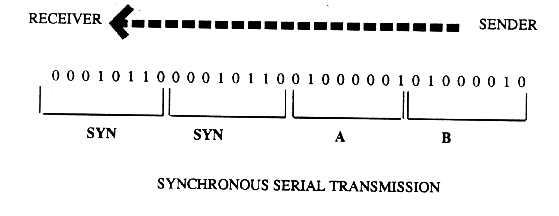

One major difficulty in data transmission is that of synchronising the receiver with the sender. Clearly, this is particularly true in serial data transfer, where the receiver must be able to detect the beginning of each new character in the bit stream being presented to it. Obviously, if it is unable to achieve this, it will not be able to interpret the incoming bit stream correctly. Two approaches exist to solve the problem of synchronisation: these are asynchronous and synchronous transmission.
Asynchronous Transmission
Using this approach, synchronisation is implemented at character level and each individual character is transmitted along with the necessary control information to allow this to take place. The control information consists of additional bits added to each character, START BITS - which indicate that transmission is about to commence - and STOP BITS - which indicate that it is about to cease. Usually, the stop bits are of the same polarity as the Channel idle state (for example zero) and consequently the start bits are of opposite polarity.
The initial change in the state of polarity, from the idle state to the first bit, is known as the START PULSE. Clearly, this enables the receiver's clock to be synchronised with the transmitter's clock.
The diagram below shows one common system, using two start bits and one stop bit, to transmit "ABC":

Associated with the approach of asynchronous transmission are various advantages.
On the other hand, an asynchronous transmission system has extensive disadvantages.
Thus, in conclusion, asynchronous serial transmission is normally only used for speeds of up to 3000 bits per second, with only simple, single-character error detection.
Synchronous Transmission
Thus second approach again transmits the message via a single channel. However, in this instance it is imperative to note that there is no control information associated with INDIVIDUAL characters. Instead the characters are grouped together in blocks of some fixed size and each block transmitted is preceded by one or more special synchronisation characters, which can be recognised by the receiver. ASCII provides a control character, SYN (ASCII code 22) for this unique purpose.
On this occasion, the diagram below shows how "ABC" would be transmitted on a synchronous system, preceded by two SYN characters:

As with asynchronous transmission it is apparent that the synchronous approach offers advantages.
Yet the synchronous approach also suffers from a few detrimental attributes.
Thus, in conclusion, serial synchronous transmission is principally used for high-speed communication between computers.